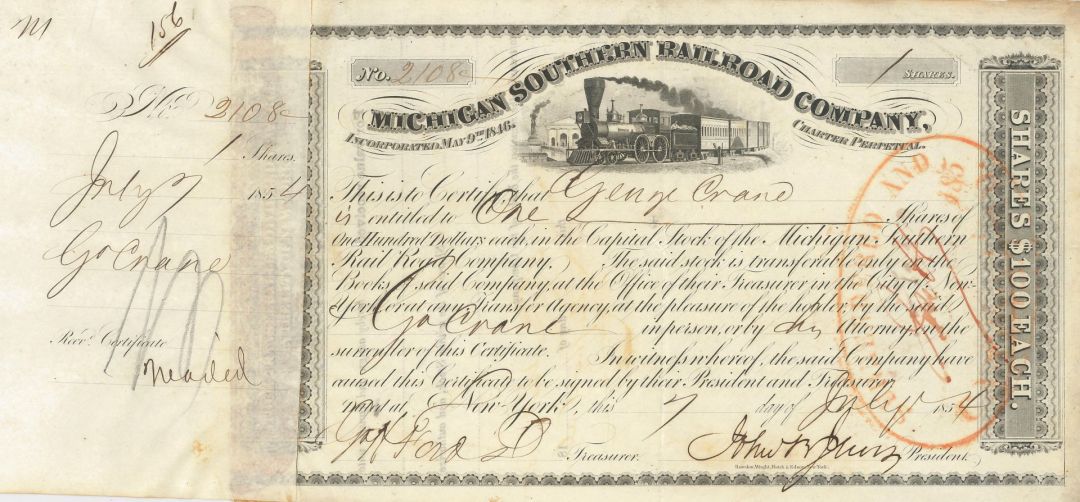Michigan Southern Railroad Co. signed by John B. Jervis - Autograph Railway Stock Certificate
Inv# RS1121 StockRailroad Stock. Vignette of steam train, etc. Great engraved early stock by Rawdon, Wright & Hatch. Rare!!! Signed by John B. Jervis.
The Northern Indiana and Chicago Railroad was chartered on November 30, 1850. Its initial tracks, from the Michigan Southern at the state line running west-southwest to Elkhart, IN then west through Osceola and Mishawaka to South Bend, IN, opened on October 4, 1851. The full line west to Chicago opened on February 20, 1852, (running to the predecessor of today's LaSalle Street Station, together with the Chicago and Rock Island Railroad north of Englewood, IL). A more direct line was soon planned from Elkhart east to Toledo, and the Northern Indiana Railroad was chartered in Ohio on March 3, 1851. On July 8, 1853, the Ohio and Indiana companies merged, and on February 7, 1855, the Northern Indiana and Chicago Railroad and the Buffalo and Mississippi Railroad were merged into the Northern Indiana Railroad. On April 25, 1855, that company in turn merged with the Michigan Southern Rail Road to form the Michigan Southern and Northern Indiana Railroad. In 1858, the new alignment (Northern Indiana Air Line) from Elkhart, IN east to Air Line Junction in Toledo, OH was completed. The company now owned a main line from Chicago to Toledo, with an alternate route through southern Michigan east of Elkhart, and a branch off that alternate to Monroe, MI. Also included was the Detroit, Monroe and Toledo Railroad, leased July 1, 1856, and providing a branch from Toledo past Monroe to Detroit. Read more at https://en.wikipedia.org/wiki/Lake_Shore_and_Michigan_Southern_Railway
John Bloomfield Jervis (December 14, 1795 – January 12, 1885) was an American civil engineer. America's leading consulting engineer of the antebellum era (1820–60), Jervis designed and supervised the construction of five of America's earliest railroads, was chief engineer of three major canal projects, designed the famous, pioneering, DeWitt Clinton steam locomotive in 1831 while with the Mohawk & Hudson RR, designed the first locomotive with a swiveling 4-wheeled front bogie truck in 1832 for the M&H RR, designed and built the 41-mile Croton Aqueduct – New York City's fresh water supply from 1842 to 1891 – and was a consulting engineer for the Boston water system.
John Bloomfield Jervis was born in 1795 at Huntington, New York, on Long Island, the son of Timothy Jervis, a carpenter, and Phoebe Bloomfield, the eldest of seven children. Jervis moved with his family to Fort Stanwix (later known as Rome) in upstate New York in 1798 when his father purchased a farm and ran a lumber business. In October 1817 at the age of 22, Jervis was hired by Chief Engineer Benjamin Wright of the Erie Canal as an axeman in a survey party to locate the canal west of Rome, New York. The role of the axemen was to clear away brush and trees along a "trace" four feet wide.(Ibid.) In the spring of 1818, Jervis became a rodman until the canal was located from Rome to Montezuma on July 10, 1818. (Ibid.) By the end of 1818, Jervis was promoted to resident engineer in charge of a canal section seventeen miles long and promoted to General Superintendent of the Eastern Division in 1824. Read more at https://en.wikipedia.org/wiki/John_B._Jervis
A stock certificate is issued by businesses, usually companies. A stock is part of the permanent finance of a business. Normally, they are never repaid, and the investor can recover his/her money only by selling to another investor. Most stocks, or also called shares, earn dividends, at the business's discretion, depending on how well it has traded. A stockholder or shareholder is a part-owner of the business that issued the stock certificates.










Ebay ID: labarre_galleries